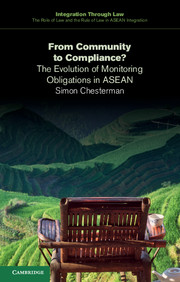3 - Typologies of Monitoring: A Toolkit
Published online by Cambridge University Press: 05 March 2015
Summary
The preceding chapters have examined the evolution of monitoring in ASEAN and developed a taxonomy of purposes for which monitoring may be intended. This final chapter offers a toolkit for future monitoring exercises, drawing on ASEAN and other international experience.
Many factors will affect the institutional design of a monitoring mechanism, most obviously the purpose to be served but also the resources available. As we have seen, ASEAN's approach to monitoring has frequently been shaped also by wariness of exposing domestic activities to external scrutiny, and a more general preference for facilitating compliance rather than objectively assessing it in either a formal or substantive sense. Without taking a position on the desirability of different approaches, this chapter is intended to clarify the options available so that informed choices can be made about the appropriate model to adopt for a given situation. In practice, of course, design of a monitoring mechanism will often be governed by supply – that is, the willingness of states to subject themselves to monitoring – rather than demand. But for present purposes the intention is to highlight such choices so that there is at least clarity about the decisions that are being made.
Three preliminary points about the design of a monitoring regime should be made. The first concerns legal transplantation. There is, of course, value in learning from the experiences of other regions. But there are significant limits to what can be achieved by uncritically exporting mechanisms that work in one region to another, or drawing conclusions based on dubious comparisons between the needs and interests of members. A spectacular example of the limitation of such an approach to reforming institutions was the ‘law and development’ movement of the 1960s. This was an ambitious programme run by the US Agency for International Development, the Ford Foundation, and other private American donors seeking to reform the laws and judicial institutions of countries in Africa, Asia and Latin America.
- Type
- Chapter
- Information
- From Community to Compliance?The Evolution of Monitoring Obligations in ASEAN, pp. 79 - 96Publisher: Cambridge University PressPrint publication year: 2015

